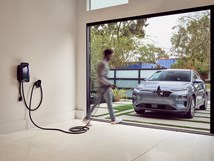Hyundai Develops Smart Transmission
Advanced sensors and artificial intelligence coordinate shifts to road conditions
#electronics
The name of Hyundai’s new transmission technology is somewhat vague. It also is a mouthful: Information and Communication Technology (ICT) Connected Shift System.
But the concept itself is forward-thinking. Literally.
Automatic Shift Predictions
In what’s touted as a world first, ICT uses information about upcoming road and traffic conditions to automatically shift the transmission.
It’s designed to find the right gear, at the right time. Whether you’re driving up a hill, swerving around a corner, merging ahead or slowing for traffic.
Points of Interest
ICT builds on existing transmission control systems that allow drivers to select among different settings, such as sport or efficiency modes.

Source: Hyundai/Kia
The new system takes this a step further by incorporating real-time data from driver-assist sensors, high-definition maps and other inputs.
The 3D maps include precise elevation, gradient and curvature measurements. Radar detects the relative speed and distance of nearby vehicles, while a forward-looking camera provides lane information.
Rapid Acceleration and Decision Time
The information is fed into an artificial intelligence algorithm that calculates the optimal transmission setting and automatically shifts gears accordingly.

When entering a highway, for example, a sport setting is applied and shifts are timed with rapid acceleration to help drivers smoothly merge into traffic flow. Once this has been accomplished, the vehicle automatically returns to the base driving mode.
Conversely, the system can shift the transmission into neutral if an extended but gradual slowdown in traffic is detected.
During tests on a curvy road, vehicles equipped with ICT were able to navigate turns with 43% fewer shifts. As a result, drivers didn’t have to brake as much, which the carmaker notes improves efficiency and reduces fatigue.
ITC Predicts Your Next Move
The engine brakes are automatically applied as the accelerator pedal is released in preparation of a downhill slope, reduced speed limit or even an upcoming speed bump.
In addition, the system can change gears in anticipation of a slowdown as the closing distance to preceding vehicles shortens.
Hyundai says future advances also could be made to use V2X technology to coordinate gear shifts with traffic lights. ICT also is designed to be used in future self-driving vehicles.
Naming Hyundai’s ITC
Hyundai developed the system with its Kia affiliate. The partners have applied for about 40 patents related to the technology and plan to introduce it on unspecified future models.
Now they only need to come up with a better name. One option: Intelligent Control Transmission, which would maintain the ICT nomenclature. But Smart Shift is even better. It’s crisp and precise, just as the technology is described.
RELATED CONTENT
-
On the 2016 Chevrolet Camaro: The Sixth Generation
The fifth-generation Camaro brought the nameplate back from what could have been oblivion. The sixth is taking it in the right direction.
-
Chevy Develops eCOPO Camaro: The Fast and the Electric
The notion that electric vehicles were the sort of thing that well-meaning professors who wear tweed jackets with elbow patches drove in order to help save the environment was pretty much annihilated when Tesla added the Ludicrous+ mode to the Model S which propelled the vehicle from 0 to 60 mph in less than 3 seconds.
-
Lincoln Corsair Takes Flight
“We wanted to create a dramatic, youthful Lincoln with terrific harmony.” And with the Corsair, they’ve accomplished what they set out to do.








